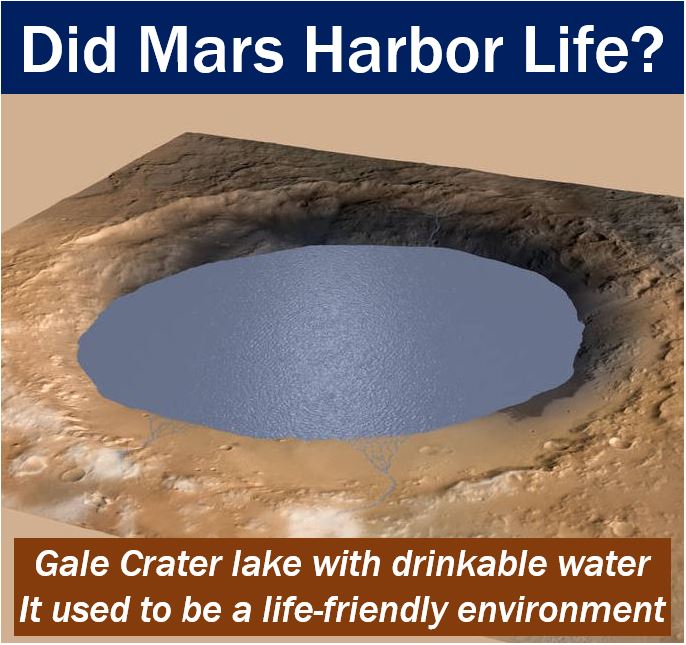Halos discovered on Mars lengthen the time frame for the possible existence of life on the Red Planet, says an international group of scientists from the United States, United Kingdom, France, Canada, Russia and Denmark. The ‘halos’ that the scientists refer to are not bright glowing rings that surround the heads of saints, but rather lighter-toned bedrock that surrounds fractures which contain high concentrations of silica.
Halos have been found in the Gale crater on the Red Planet, suggesting that Mars had liquid water for considerably longer than previously thought.
The scientists wrote about their study and findings in the prestigious journal Geophysical Research Letters, which belongs to the American Geophysical Union. The article, titled ‘Diagenetic silica enrichment and late-stage groundwater activity in Gale crater, Mars‘, was published on May 30th, 2017.
 A mosaic of pictures from NASA Curiosity rover’s navigation cameras shows ‘halos’ – lighter-toned bedrock – around fractures. These halos contain high levels of silica and suggest that liquid groundwater flowed through the Gale crater rocks for much longer that scientists had previously believed. (Image: Adapted from Los Alamos National Directory. Original Image Credit: NASA/JPL-Caltech)
A mosaic of pictures from NASA Curiosity rover’s navigation cameras shows ‘halos’ – lighter-toned bedrock – around fractures. These halos contain high levels of silica and suggest that liquid groundwater flowed through the Gale crater rocks for much longer that scientists had previously believed. (Image: Adapted from Los Alamos National Directory. Original Image Credit: NASA/JPL-Caltech)
According to data gathered from NASA Curiosity rover’s science payload, the concentration of silica is extremely high at these halos’ centerlines. The authors believe that silica migrated between very old sedimentary bedrock into overlying – and much younger – rocks.
Halos raise prospect of life on Mars
Lead author, Jens Frydenvang, who works at Los Alamos National Laboratory in the USA, and the University of Copenhagen in Denmark, said:
“The goal of NASA’s Curiosity rover mission has been to find out if Mars was ever habitable, and it has been very successful in showing that Gale crater once held a lake with water that we would even have been able to drink, but we still don’t know how long this habitable environment endured.”
“What this finding tells us is that, even when the lake eventually evaporated, substantial amounts of groundwater were present for much longer than we previously thought – thus further expanding the window for when life might have existed on Mars.”
 According to NASA: “Evidence of ancient streams, deltas and lakes that NASA’s Curiosity Mars rover mission has found in the patterns of sedimentary deposits in Gale Crater suggests the crater held a lake such as this more than three billion years ago, filling and drying in multiple cycles over tens of millions of years.” (Image: adapted from nasa.gov)
According to NASA: “Evidence of ancient streams, deltas and lakes that NASA’s Curiosity Mars rover mission has found in the patterns of sedimentary deposits in Gale Crater suggests the crater held a lake such as this more than three billion years ago, filling and drying in multiple cycles over tens of millions of years.” (Image: adapted from nasa.gov)
We do not know whether this groundwater could have sustained life, the authors wrote. However, their new study buttresses the recent findings of another study, carried out by Los Alamos scientists, who found boron on the Red Planet for the first time, which also suggests that maybe there was once the potential for long-term habitable groundwater on Mars.
The halos were analyzed by Curiosity’s suite of instruments, including the ChemCham instrument (ChemCham stands for Chemistry and Camera).
The Curiosity rover has traveled more than 16 km (10 miles) over 1,700 Martian days (sols), during which it went from the bottom of Gale crater to the half-way point up Mount Sharp in the center of the crater.
Researchers have been gathering and analyzing all the ChemCham data to put together a more complete picture of Mars’ geological history.
The higher silica level in the halos was found about twenty to thirty meters in elevation close to a rock-layer of ancient lake sediments which had a high silica content.
Ancient Mars had liquid water for a long time based on the pale “halos” of silica around fractures in bedrock: https://t.co/prfEQGENBH pic.twitter.com/TmvsduT4DL
— NASA (@NASA) May 30, 2017
Regarding the silica in the halos of the younger rocks, Frydenvang said:
“This tells us that the silica found in halos in younger rocks close by was likely remobilized from the old sedimentary rocks by water flowing through the fractures.”
Some of the rocks that contained halos were deposited by wind, probably as dunes. Dunes of this type could only exist after all the water in the lake had dried up.
The fact that halos were present in the rocks that formed long after the lake became dry suggests that groundwater was still flowing within the rocks more recently than previously thought.
Video – Halos and chances of life on Mars
Ever since NASA’s Curiosity rover landed on the Red Planet in 2012, it has been looking for answers to the same question: “Did the Red Planet ever harbor life?”
Curiosity has already showed us that once there was a large lake with drinkable water, but nobody knows how long that potentially life-supporting environment existed. The discovery of halos suggests that this life-friendly environment existed for much longer than previously thought.
